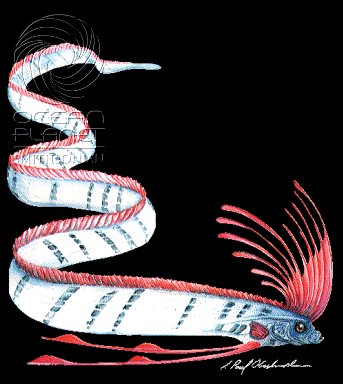 If you don't believe in sea monsters, consider yourself warned: They are among us. Exhibit A lies in a freezer at the Los Angeles Natural History Museum, soon to go on display as it appeared before being pulled from the ocean: a serpent-like denizen, 15 feet long and sinuous, with a hatchet-shaped head and a silver body adorned by a flowing crimson mane.
If you don't believe in sea monsters, consider yourself warned: They are among us. Exhibit A lies in a freezer at the Los Angeles Natural History Museum, soon to go on display as it appeared before being pulled from the ocean: a serpent-like denizen, 15 feet long and sinuous, with a hatchet-shaped head and a silver body adorned by a flowing crimson mane.If that's not enough, evidence of larger and perhaps scarier beasts in our seas is under scrutiny at Santa Barbara's Museum of Natural History: a 10-foot slithery tentacle and two stout sucker-pocked arms that had previously belonged to a creature measuring perhaps 20 feet. The recent capture of an oarfish in a Santa Catalina Island embayment, and the discovery by sport fishermen of giant squid appendages near Santa Cruz Island, have scientists excited. Both finds are rare specimens.
The oarfish, a deepwater species so named because of long, oar-shaped fins that dangle from its sides, startled swimmers when it appeared in Catalina's Big Fisherman's Cove on the morning of Aug. 16. It was clearly in distress, moving lethargically and bumping into rocks. Harbormaster Doug Oudin, who donned snorkeling gear and swam with the fish before it eventually perished, described its coloring as "metallic silver with bright blue-brown spots and splotches, along with its amazing pinkish-red full-length dorsal fin." Oudin added that the oarfish appeared to be blind, not surprising, considering that these animals, which have large saucer-shaped eyes, live at lightless depths of 1,500 to 3,000 feet.
Little else is known about these longest of bony fishes because so few have been found, but, like the giant squid, they're steeped in lore, believed responsible for spawning tales of sea serpents and dragons rising demonically to steal crewmen and sink tall ships. Their modern discovery may date to 1808, when a 56-foot serpent-like creature washed ashore in Scotland. In 1901, a 22-foot oarfish drifted onto the sand in Newport Beach, becoming, according to one reference book, "the basis for many sea-serpent stories told by local bar patrons for more than a decade after its discovery."
Oarfish are not monsters, of course. They have tiny mouths and, moving through the blackness the way a snake slithers over land, they prey largely upon krill — tiny crustaceans — and sea jellies.
Below is a picture of the Giant Oarfish caught at the US Navy SEAL training center on Coronado Island, just off the coast of San Diego, California. The photo was taken in 1996! Giant Oarfish are one of the strangest looking fish that you will ever see. It is believed that Giant Oarfish which get up to 50 feet long, have been the source of many sea monster reports. Take a look at the photo and I think you will understand why!

No comments:
Post a Comment